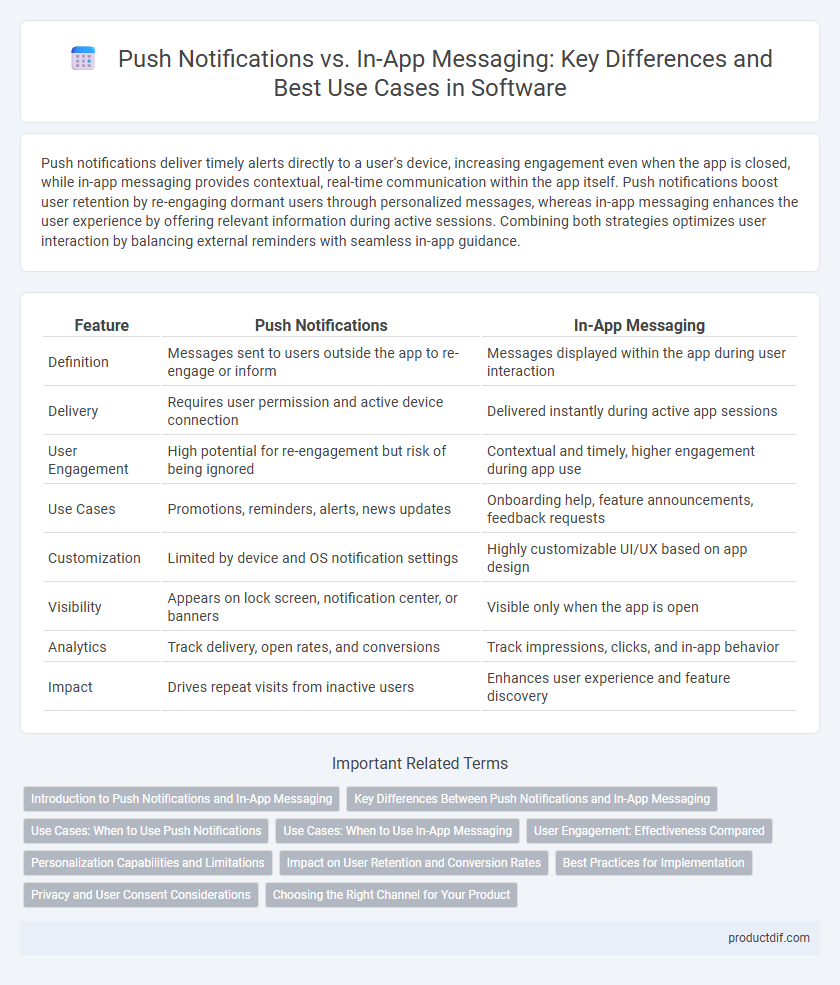Push notifications deliver timely alerts directly to a user's device, increasing engagement even when the app is closed, while in-app messaging provides contextual, real-time communication within the app itself. Push notifications boost user retention by re-engaging dormant users through personalized messages, whereas in-app messaging enhances the user experience by offering relevant information during active sessions. Combining both strategies optimizes user interaction by balancing external reminders with seamless in-app guidance.
Table of Comparison
| Feature | Push Notifications | In-App Messaging |
|---|---|---|
| Definition | Messages sent to users outside the app to re-engage or inform | Messages displayed within the app during user interaction |
| Delivery | Requires user permission and active device connection | Delivered instantly during active app sessions |
| User Engagement | High potential for re-engagement but risk of being ignored | Contextual and timely, higher engagement during app use |
| Use Cases | Promotions, reminders, alerts, news updates | Onboarding help, feature announcements, feedback requests |
| Customization | Limited by device and OS notification settings | Highly customizable UI/UX based on app design |
| Visibility | Appears on lock screen, notification center, or banners | Visible only when the app is open |
| Analytics | Track delivery, open rates, and conversions | Track impressions, clicks, and in-app behavior |
| Impact | Drives repeat visits from inactive users | Enhances user experience and feature discovery |
Introduction to Push Notifications and In-App Messaging
Push notifications are alerts sent directly to a user's device from an app, designed to capture attention even when the app is not actively in use, enhancing engagement through timely updates and personalized offers. In-app messaging, conversely, occurs within the app interface, providing contextual communication during active sessions to improve user experience and guide behavior without disrupting the current task. Both channels leverage real-time interaction but serve distinct roles in user retention and conversion strategies within mobile and web applications.
Key Differences Between Push Notifications and In-App Messaging
Push notifications deliver timely alerts directly to users' devices even when the app is closed, enhancing engagement through real-time updates and reminders. In-app messaging appears within the app interface only during active sessions, allowing for contextual communication and personalized offers based on user behavior. Key differences include delivery method, user engagement timing, and ability to target users passively versus actively, influencing retention and conversion strategies.
Use Cases: When to Use Push Notifications
Push notifications are ideal for time-sensitive alerts such as flash sales, order updates, or critical security alerts that require immediate user attention. They effectively re-engage inactive users by delivering external reminders directly to the device's home screen or lock screen. Push notifications increase app visibility and drive user action when messages must be received even if the app is closed or inactive.
Use Cases: When to Use In-App Messaging
In-app messaging is ideal for delivering context-specific updates and feature announcements while users are actively engaged within an app, enhancing real-time interaction without interrupting the user experience. It effectively supports onboarding processes, guides users through new features, and encourages in-app purchases by providing targeted prompts. This method ensures higher engagement rates for time-sensitive or personalized content compared to push notifications, which are better suited for re-engagement outside the app.
User Engagement: Effectiveness Compared
Push notifications drive user re-engagement by delivering timely alerts directly to the device screen, resulting in higher open rates and immediate attention. In-app messaging enhances user engagement during active sessions by providing contextually relevant information without interrupting the user flow. Data shows push notifications achieve up to 40% higher click-through rates, while in-app messages increase feature adoption and retention by up to 30%.
Personalization Capabilities and Limitations
Push notifications enable broad personalization through user segmentation and behavioral triggers but may face delivery limitations due to device settings or user opt-outs. In-app messaging offers granular, real-time customization based on user interactions within the app, providing richer context and higher engagement potential. However, its reach is limited to active app sessions, restricting effectiveness outside user engagement periods.
Impact on User Retention and Conversion Rates
Push notifications significantly enhance user retention by delivering timely alerts that re-engage users even when the app is closed, increasing conversion rates by an average of 9%. In-app messaging boosts conversion by providing personalized and contextual content during active user sessions, resulting in a 15% higher engagement rate compared to push notifications. Combining both strategies optimizes user experience and maximizes retention and conversion outcomes.
Best Practices for Implementation
Push notifications should be strategically personalized and timed to increase user engagement without causing fatigue, leveraging user behavior data and preferences for relevant content delivery. In-app messaging works best when integrated contextually within the app experience, providing seamless interaction and real-time responses to user actions for higher conversion rates. Combining both channels with careful frequency management and A/B testing ensures optimal communication balance and enhances overall user retention.
Privacy and User Consent Considerations
Push notifications require explicit user consent to comply with privacy regulations like GDPR and CCPA, as they can be perceived as intrusive when delivered outside the app environment. In-app messaging, being contained within the app, offers a more controlled and contextually relevant user experience with less risk of violating user privacy. Ensuring transparent consent management and minimizing data collection are critical for both channels to maintain user trust and comply with privacy standards.
Choosing the Right Channel for Your Product
Push notifications deliver timely alerts directly to users' devices, ideal for driving immediate engagement and re-engagement outside the app. In-app messaging enhances user experience by providing context-specific communication within the app, perfect for onboarding, feature highlights, or personalized promotions. Selecting the right channel depends on your product's user behavior, engagement goals, and desired interaction timing to maximize retention and conversion rates.
Push Notifications vs In-App Messaging Infographic

 productdif.com
productdif.com